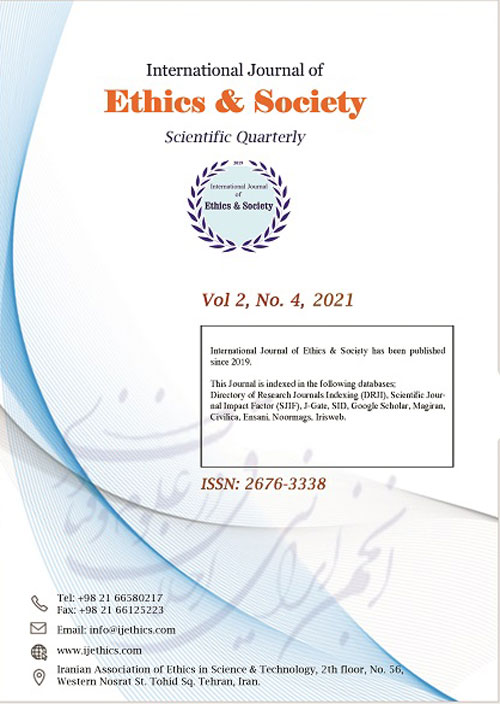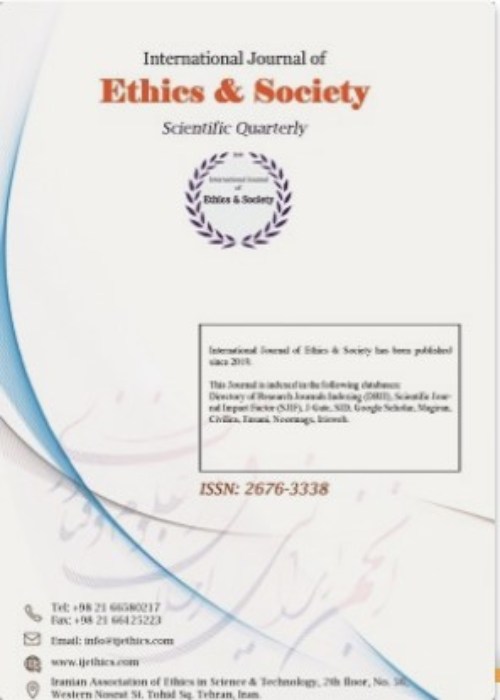فهرست مطالب

International Journal of Ethics & Society
Volume:2 Issue: 3, Autumn 2020
- تاریخ انتشار: 1400/01/08
- تعداد عناوین: 6
-
-
Pages 1-9Background
The aim of this study was to compare the ethical status of public and non-profit elementary school students.
MethodThe method of the present study was descriptive-correlational and in terms of purpose, it is an applied study. The statistical population of the whole elementary students of the second period (fourth to sixth grades) in Tehran in the academic year 2018-2019, based on Krejcie and Morgan table, 531 people were selected as the sample size and the sampling method was stratified sampling. The research instrument was Latifabadi Moral Development Questionnaire (2005), the validity of which was confirmed by the views of professors of psychology and educational sciences and its reliability was obtained by Cronbachchr('39')s alpha test (0.89). Data were analyzed through descriptive and inferential statistics by SPSS 24 software.
ResultsData analysis showed that there is a significant difference between the moral status of non-profit and public schools (p <0.05). In other words, the average of moral status in non-profit schools is slightly higher. There was a significant difference between the moral status of boyschr('39') and girlschr('39') schools (p <0.05). There was a significant difference between non-profit and public girlschr('39') schools (p <0.05), but there was no significant difference between non-profit and public schools for boys (p <0.05).
ConclusionBased on the research findings, it can be said that non-profit schools have a better moral status than public schools.
Keywords: Ethics, Moral development, Public, non-profit schools, Elementary students -
Pages 10-23Background
Conflicts of interest and the resulting ethical dilemmas play a decisive role in the unethical behavior of independent auditors. The main objectives of this study are to identify different situations of conflict of interest of independent auditors and the resulting ethical dilemmas and also to find strategies for managing and controlling each of these situations.
MethodIn this paper, the exploratory approach of the mixed research method (qualitative-quantitative) has been applied. The statistical population in the qualitative stage is the experts in the field of independent auditing. Accordingly theoretical sampling and after conducting semi-structured interviews, theoretical saturation was obtained and qualitative content analysis method analyzed the data. In the quantitative stage, a questionnaire is designed based on the results of the qualitative stage and distributed among a random sample of members of the statistical community who are certificated public accountants working in audit firms and the structural equation modeling method used to analyze the data.
ResultsFindings showed that independent auditors become involved in conflicts of interest and ethical issues when disagreeing with a client they fear of losing, when facing with inappropriate job opportunities, when conducting the review process, and when facing with challenges in performing tasks. Also, managing the conflict of interest of independent auditors require the collective efforts of owners, the community of certified public accountants and independent auditors at the individual level and at the level of the audit firm.
ConclusionThe results of this study are important because they can provide a good framework for promoting ethics in the auditing profession.
Keywords: Conflict of Interest, Ethical dilemmas, Strategies for Managing Conflicts of Interest of Independent Auditors, Iranian Society of Certified Public Accountants, Mixed Research -
Pages 24-36Background
In Islam, expectations are very high in respect to a desirable teacher, especially because the teacher is a model for the next generation, so the purpose of this study is to identify the moral codes of teachers according to the Islamic perspective.
MethodThe approach of the present study is qualitative and its method is synthesis research. The research population is all articles (63 articles) that have been presented from 2010 to 2020 in the field of moral components of educators from the perspective of the Holy Quran and the educational life of Imams (A) and the Prophet Mohammad (S). The research sample includes 26 articles, which have been purposefully selected based on thematic monitoring and theoretical data saturation. Research data were collected from qualitative analysis of the studied documents.
ResultsThe results showed that the moral codes of teachers from the perspective of Islam can be organized in two main dimensions including: contextual dimension (including personality components, insight, religious commitment, socio-political factors and neatness) and professional dimension (including components of professional commitment, knowledge enhancement, professional principles, interactions, content management, teaching and evaluation).
ConclusionAccording to the principles of Islam, the components of teacherschr('39') professional ethics were organized in two contextual and professional dimensions, so the managers of educational organizations can provide in-service courses for teachers to teach the components of ethics and also design a moral code of ethics taking into account the moral components of teachers in Islam.
Keywords: Moral codes, Islam, Roberts’s model -
Pages 37-46Background
The policy focuses on what the government is actually doing in practice, not just what it has proposed or intends to do, and distinguishes the policy from a decision that is merely a specific option among other options. The present study aimed to provide a model of organizational performance of employees based on organizational justice in Payam-e-Noor University.
MethodThe present study was formed with a mixed approach. In the qualitative section of the statistical population, there were experts in the field of policy-making and management of Payam-e-Noor University of Hormozgan province, 15 of whom were selected as members of the panel group through homogeneous qualitative sampling method. The research tool was an interview. In a small part of the statistical population, all managers and staff of Payam-e-Noor University of Hormozgan province were approximately 400 people, of which 200 people were selected by stratified random sampling. A researcher-made questionnaire was used to collect information. To analyze the data in the qualitative part, the grounded theory was used and in the quantitative part, structural equations were used.
ResultsThe results show that the topics of the research are 6 main variables of the research including; gender justice, protectionist perspective, empowering attitude, confidence building, ethics and social commitment. After identifying the topics, the categories of analysis were defined. Thus, in this study, 23 main categories were defined and finally the research model had a suitable fit.
ConclusionThe performance of employees in an organization is one of the most important factors increasing the efficiency of the organization and its effectiveness and the most important channel to achieve optimal performance of employees is organizational justice.
Keywords: Organizational strategies, Employee performance, Organizational justice -
Pages 47-58Background
Since preparation of financial statements is responsibility of the management of the Company, so the type of management personality is one of the critical factors influencing their behavior in performing earnings management. As a result, the dark (negative) personality dimensions can play an effective role in earnings management. On the other hand, ethical leadership can act as a moderating factor; this research measures the effect of ethical leadership style on reducing dark personality dimensions (Machiavellianism, psychopathy, narcissism) of effective person in earnings management.
MethodsThe data of 77 companies listed in the Tehran Stock Exchange (TSE) and Iran Fara Bourse (IFB) from 2011 to 2018 used in this research for testing the hypotheses. Also, the linear regression test and structural equations model used.
ResultsThe results show that most of the effective persons in earnings management are the CEOs of companies. The results also indicate a positive relationship between ethical leadership and dark personality dimensions (Machiavellianism, psychopathy, narcissism).
ConclusionThe results indicate a positive relationship between ethical leadership and the dimensions of the dark personality; This is due to the closeness of dimension of "Narcissism" to the issues of intrinsic leadership, and on the other hand, this issue could be considered close to the perspective of the person involved in earnings management and supervisors and lack of belief in ethical supervision and leadership.
Keywords: Machiavellianism, Narcissism, Psychopathy, Dark Personality, Ethical Leadership, Earnings Management -
Pages 59-64Background
Companies in a competitive environment are forced to use strategies that bring them more survival. Consumer satisfaction depends on ethical marketing, which deals with ethical principles and marketing practices and regulations. Evaluating ethical tools in marketing strategies is a strategy that increases the profitability and sustainability of companies due to attracting more customers.
MethodThis research is a qualitative research that has been done by using the data theory of the foundation with interview tools from the research community, which includes 23 academic experts, managers and experts in the field of marketing and social media who were selected by purposive sampling. Data analysis was performed with MaxQDA software in three stages: open, axial and selective
ResultsThe findings represent 104 open source codes that eventually led to the six main axes in the model.
ConclusionBased on the research results, the model includes influential factors (structural, managerial, store-related and social media-related). Social media marketing is a central phenomenon that includes (advertising, communication, and word-of-mouth electronic advertising). It encompasses the prevailing context (interactive, competitive, and globalizing environment), including intervening factors (religious, technological, and economic) that influence the ethical strategies of social media marketing. Marketing, economic and human resources actions in the form of ethical strategies lead to the formation of economic and user-related consequences.
Keywords: Social media marketing, Ethics-based strategies, Trust, Purchase intention


